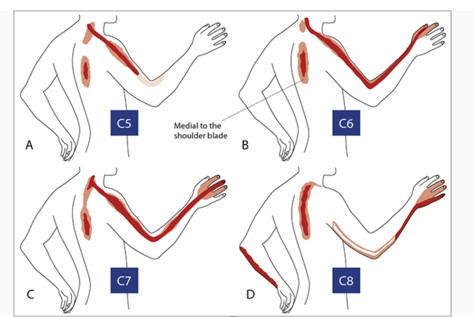Dear patient the information provided to you is based on the evidence-based literature and our experience with the intention of providing insights into your condition its symptoms and treatment available.
What is a cervical disc prolapse?
Cervical disc prolapse is acute painful condition which affects the neck. In this condition the disc moves out of its position which irritates and pinch the spinal nerves or occasionally spinal cord too. This is also called cervical disc herniation, cervical disc bulge, ruptured cervical disc or even slipped disc

What is an intervertebral disc?
Intervertebral disc is fibrocartilaginous material which is positioned between vertebral bodies, to provide function of shock absorption and some degree of movement in the spinal column.
What is the cause of disc prolapse?
The reasons are many improper posture, repetitive injuries, smoking, genetically weaker disc, poor muscle conditioning etc.
Disc herniation most often is a result of gradual wear and tear related to aging.
What is the common age and gender for disc prolapse?
30 to 50 years is the common age presentation with equal sex distribution, there can be exceptions as well with respect to age.
What are the symptoms?
Neck pain, stiffness, sometimes it can only present as pain between the shoulders, radicular or shooting pain across the upper – limb, numbness, burning sensation, pins and needles, occasional weakness are the commonly reported symptoms.

How is it diagnosed?
Patient history, clinical examination, Xray and MRI study are useful in diagnosing the condition.
Are all neck and arm pain being due to cervical disc prolapse?
Need not be, Acute Myocardial infarction may present with the same kind of symptoms if pain is in the left arm, shoulder conditions like rotator cuff tears has to be differentiated from cervical disc prolapse.
How is it treated?
At Sun Orthopaedics, over 95% patients will be managed with conservative treatment in the form of analgesics, muscle relaxants, steroid medications, collar immobilization, hot compresses and once they start feeling better muscle strengthening exercises and postural training by the support of our physiotherapist team. Patients will generally start seeing improvements in 2 to 6 weeks.
What are all the activities to be avoided?
Avoid physical strain, lifting weights, works which require continuous bending, do not use thick pillow and avoid driving until symptoms get better.
Can this condition relapse?
Yes, if advise not followed.
Is there any role for surgery?
Only in 5 % cases when symptoms are severe, spinal cord compression, persistent pain beyond 6 weeks, and with severe weakness of involved muscles.
What is the difference between cervical spondylosis and cervical disc prolapse?
In brief cervical spondylosis is a chronic condition with progressive wear and tear of disc and facet joints which occasionally causes disc herniation and pinching of nerves apart from narrowing neural foramen and spinal cord compression. On the other hand, cervical disc prolapse is an acute condition which can happen in the presence or absence of spondylosis, thought the symptoms are similar.



Follow us